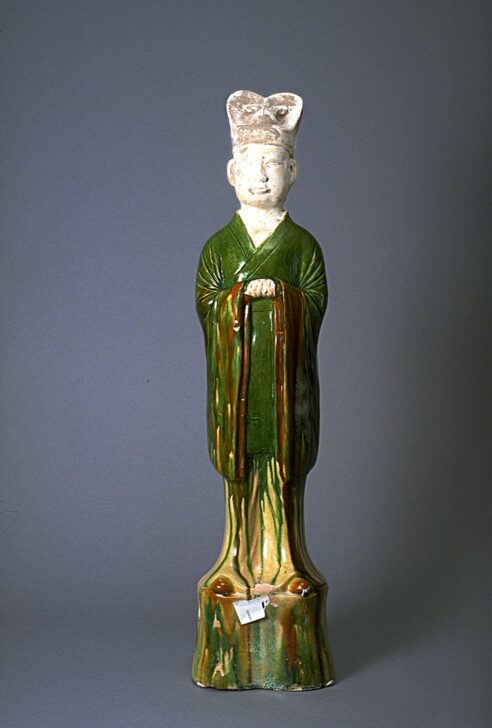Civil Official
Chinese

Description
Subject Matter:
An earthenware sancai (三彩) ("three color") mingqi (明器) ("bright object") figure of a civil official of the Tang dynasty (618-906).
The presence of a civil official (normally found in pairs) within the tomb would indicate the wealth and high status of the deceased. It would have been part of a larger set of guardian figures, warriors, horses and camels, generally all in pairs. The official's face and hands were left unglazed to be finely painted with mineral pigments to give a realistic appearance. These combination glazed and painted pieces would have been particularly expensive to produce.
During the stable and peaceful Tang Dynasty, the Silk Road brought exotic luxury goods to China, including metalwork, glass, precious stones, ivory, and textiles from Central Asian, India, and the Middle East. The bustling Tang capital of Chang’an (modern Xi’an) was a bit like the Paris and New York of today in its cosmopolitan mix of peoples, cultures, music, foods, and goods, especially from Central Asia.
Sancai was one of the most brilliant innovations of Tang dynasty potters. Working with the same clay used to produce white wares, potters added iron, copper, and cobalt oxide colorants to create the typical three-color palette of cream, amber, olive green and cobalt blue. Sancai ware can contain any combination of just two to all four colors. Cobalt oxide was a new import from Persia and was a key component in the development of the three-colored glaze palette. Lead flux made it possible for these colored glazes to fuse to the earthenware body at relatively low kiln temperatures. It also allowed glazes to run, which made them very difficult to control, yet aesthetically appealing.
Sancai, flourished from around 680 to 750 under the patronage of the Tang elite for the production of tomb figurines and mingqi, or funerary pottery. Since the Qin dynasty (221 - 206 BCE), ceramic figures have been used to replace human sacrifice in burial practices as a way to provide for the deceased. The number of ceramic mingqi items in a tomb could reach numbers of a few to several hundred objects.
Physical Description:
A standing civil official of earthenware, wearing a long robe with wide sleeves and with hands clasped in front of his chest. He is wearing a tall hat divided into two lobes and standing on a tall pedestal. With the exception of the head and hands, the figure is covered in runny amber, green and cream glazes.
Usage Rights:
If you are interested in using an image for a publication, please visit https://umma.umich.edu/request-image/ for more information and to fill out the online Image Rights and Reproductions Request Form.